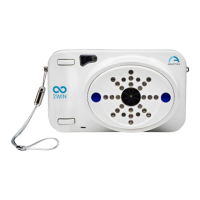20
8 Description of the device
8.1 2WIN
The measuring principle of the device is based on infrared photorefraction. In this technique,
infrared light is projected through the pupils of the patient onto the retina. Depending on the
refractive error, the reflected light forms a specific crescent-shaped brightness pattern within
the pupil. The spherical refraction is calculated based on this crescent pattern. Cylinder and
axis measurements are based on the same kind of calculation, repeated on four meridians.
This device performs the measurement 1 meter (3 feet 3 inches) away from the patient
(contact-less), with continuous tracking of the corneal reflex, for the analysis of the binocular
alignment, and with sensor for checking the measurement distance.
The device accepts a pupil diameter between 4 and 7 millimetres (it is possible to measure
down to 3.5 and up to 11 mm but this depends on good environmental conditions. Outside
the 4-7 mm range the overall precision could decrease and it is compatible with the measure
in mydriasis and in miosis.
It incorporates sight and sound stimula for the use with children and uncooperative patients
(sound is preferable to sight stimula). The device is portable, battery powered, equipped
with a computing integrated unit and with a display for verification of the conditions of
measurement and for displaying the results. This is controlled via push buttons. It can be
connected to a mini-printer, via IrDA (Infrared Data Association) interface, to print the
measurement results onto a strip of paper. 2WIN data can be saved inside the 2WIN and
downloaded outside the instrument through USB connection or WiFi LAN. Moreover, data
can be sent through email service to the operator email address once it is saved in the 2WIN
or finally can be sent to an email printing enabled WiFi printer.

